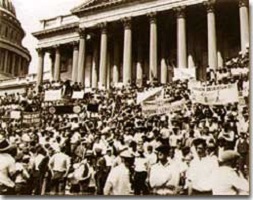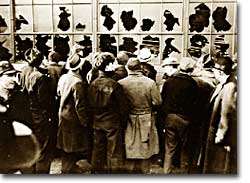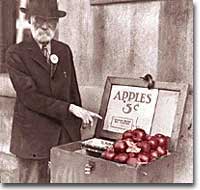48c. The Bonus March

World War I veterans block the steps of the Capitol during the Bonus March, July 5, 1932.
Many in America wondered if the nation would survive.
Although the United States had little history of massive social upheaval or coup attempts against the government, hunger has an ominous way of stirring those passions among any population. As bread riots and shantytowns grew in number, many began to seek alternatives to the status quo. Demonstrations in the nation's capital increased, as Americans grew increasingly weary with President Hoover's perceived inaction. The demonstration that drew the most national attention was the Bonus Army march of 1932.
In 1924, Congress rewarded veterans of World War I with certificates redeemable in 1945 for $1,000 each. By 1932, many of these former servicemen had lost their jobs and fortunes in the early days of the Depression. They asked Congress to redeem their Bonus certificates early.

Workers and their unions fought poor working conditions by walking off the job. Violence often erupted when factory owners tried to break the "strike." These broken windows are a result of the Flint, Michigan, sit-down strike of 1936-37.
Led by Walter Waters of Oregon, the so-called Bonus Expeditionary Force set out for the nation's capital. Hitching rides, hopping trains, and hiking finally brought the Bonus Army, now 15,000 strong, into the capital in June 1932. Although President Hoover refused to address them, the veterans did find an audience with a congressional delegation. Soon a debate began in the Congress over whether to meet the demonstrators' demands.
As deliberation continued on Capitol Hill, the Bonus Army built a shantytown across the Potomac River in Anacostia Flats. When the Senate rejected their demands on June 17, most of the veterans dejectedly returned home. But several thousand remained in the capital with their families. Many had nowhere else to go. The Bonus Army conducted itself with decorum and spent their vigil unarmed.

Conditions during the Depression were so bad that some city governments devised programs that had the unemployed selling apples to make a living. This man was one of nearly 700 apple vendors in Detroit.
However, many believed them a threat to national security. On July 28, Washington police began to clear the demonstrators out of the capital. Two men were killed as tear gas and bayonets assailed the Bonus Marchers. Fearing rising disorder, Hoover ordered an army regiment into the city, under the leadership of General Douglas MacArthur. The army, complete with infantry, cavalry, and tanks, rolled into Anacostia Flats forcing the Bonus Army to flee. MacArthur then ordered the shanty settlements burned.
Many Americans were outraged. How could the army treat veterans of the Great War with such disrespect? Hoover maintained that political agitators, anarchists, and communists dominated the mob. But facts contradict his claims. Nine out of ten Bonus Marchers were indeed veterans, and 20% were disabled. Despite the fact that the Bonus Army was the largest march on Washington up to that point in history, Hoover and MacArthur clearly overestimated the threat posed to national security. As Hoover campaigned for reelection that summer, his actions turned an already sour public opinion of him even further bottomward.
America sank deeper in Depression.





